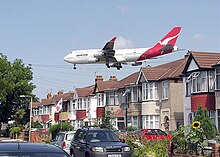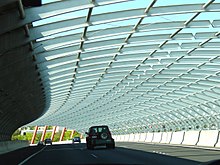Noise pollution

Noise pollution (or environmental noise) is displeasing human- or machine-created sound that disrupts the activity or balance of human or animal life. A common form of noise pollution is from transportation, principally motor vehicles.[1] The word noise comes from the Latin word noxia meaning "injury" or "hurt".
The source of most noise worldwide is transportation systems, motor vehicle noise, but also including aircraft noise and rail noise.[2][1] Poor urban planning may give rise to noise pollution, since side-by-side industrial and residential buildings can result in noise pollution in the residential area.
Other sources are car alarms, office equipment, factory machinery, construction work, groundskeeping equipment, barking dogs, appliances, power tools, lighting hum, audio entertainment systems, loudspeakers and noisy people.
Human health effects
Noise health effects are both health and behavioural in nature. The unwanted sound is called noise. This unwanted sound can damage physiological and psychological health. Noise pollution can cause annoyance and aggression, hypertension, high stress levels, tinnitus, hearing loss, sleep disturbances, and other harmful effects.[3][4][5] Furthermore, stress and hypertension are the leading causes to health problems, whereas tinnitus can lead to forgetfulness, severe depression and at times panic attacks.[4][6]
Chronic exposure to noise may cause noise-induced hearing loss. Older males exposed to significant occupational noise demonstrate significantly reduced hearing sensitivity than their non-exposed peers, though differences in hearing sensitivity decrease with time and the two groups are indistinguishable by age 79.[7] A comparison of Maaban tribesmen, who were insignificantly exposed to transportation or industrial noise, to a typical U.S. population showed that chronic exposure to moderately high levels of environmental noise contributes to hearing loss.[3]S. Rosen and P. Olin, Hearing Loss and Coronary Heart Disease, Archives of Otolaryngology, 82:236 (1965)</ref>
High noise levels can contribute to cardiovascular effects and exposure to moderately high levels during a single eight hour period causes a statistical rise in blood pressure of five to ten points and an increase in stress[3] and vasoconstriction leading to the increased blood pressure noted above as well as to increased incidence of coronary artery disease.
Noise pollution is also a cause of annoyance. A 2005 study by Spanish researchers found that in urban areas households are willing to pay approximately four Euros per decibel per year for noise reduction.[8]
Environmental effects
Noise can have a detrimental effect on animals by causing stress, increasing risk of mortality by changing the delicate balance in predator/prey detection and avoidance, and by interfering with their use of sounds in communication especially in relation to reproduction and in navigation. Acoustic overexposure can lead to temporary or permanent loss of hearing.[9]
An impact of noise on animal life is the reduction of usable habitat that noisy areas may cause, which in the case of endangered species may be part of the path to extinction. One of the best known cases of damage caused by noise pollution is the death of certain species of beached whales, brought on by the loud sound of military sonar.[10]
Noise also makes species communicate louder, which is called Lombard vocal response.[11] Scientists and researchers have conducted experiments that show whales' song length is longer when submarine-detectors are on.[12] If creatures don't "speak" loud enough, their voice will be masked by anthropogenic sounds. These unheard voices might be warnings, finding of prey, or preparations of net-bubbling. When one species begins speaking louder, it will mask other species' voice, causing the whole ecosystem to eventually speak louder.
Zebra finches become less faithful to their partners when exposed to traffic noise. This could alter a population's evolutionary trajectory by selecting traits, sapping resources normally devoted to other activities and thus lead to profound genetic and evolutionary consequences.[13]
Mitigation and control of noise

Technology to mitigate or remove noise can be applied as follows:
There are a variety of strategies for mitigating roadway noise including: use of noise barriers, limitation of vehicle speeds, alteration of roadway surface texture, limitation of heavy vehicles, use of traffic controls that smooth vehicle flow to reduce braking and acceleration, and tire design. An important factor in applying these strategies is a computer model for roadway noise, that is capable of addressing local topography, meteorology, traffic operations and hypothetical mitigation. Costs of building-in mitigation can be modest, provided these solutions are sought in the planning stage of a roadway project.
Aircraft noise can be reduced to some extent by design of quieter jet engines, which was pursued vigorously in the 1970s and 1980s. This strategy has brought limited but noticeable reduction of urban sound levels. Reconsideration of operations, such as altering flight paths and time of day runway use, have demonstrated benefits for residential populations near airports. FAA sponsored residential retrofit (insulation) programs initiated in the 1970s has also enjoyed success in reducing interior residential noise in thousands of residences across the United States.
Exposure of workers to Industrial noise has been addressed since the 1930s. Changes include redesign of industrial equipment, shock mounting assemblies and physical barriers in the workplace.
Legal status
Governments up until the 1970s viewed noise as a "nuisance" rather than an environmental problem. In the United States there are federal standards for highway and aircraft noise; states and local governments typically have very specific statutes on building codes, urban planning and roadway development. In Canada and the EU there are few national, provincial, or state laws that protect against noise.
Noise laws and ordinances vary widely among municipalities and indeed do not even exist in some cities. An ordinance may contain a general prohibition against making noise that is a nuisance, or it may set out specific guidelines for the level of noise allowable at certain times of the day and for certain activities.
Dr. Paul Herman wrote the first comprehesive noise codes in 1975 for the City of Portland Oregon with funding from the EPA (Environmental Protection Agency) and HUD (Housing and Urban Development). The Portland Noise Code became the basis for most other ordinances for major US and Canadian metropolitan regions. [1]
Most city ordinances prohibit sound above a threshold intensity from trespassing over property line at night, typically between 10 p.m. and 6 a.m., and during the day restricts it to a higher sound level; however, enforcement is uneven. Many municipalities do not follow up on complaints. Even where a municipality has an enforcement office, it may only be willing to issue warnings, since taking offenders to court is expensive.
The notable exception to this rule is the City of Portland Oregon which has instituted an aggressive protection for its citizens with fines reaching as high at $5000 per infraction, with the ability to cite a responsible noise violator multiple times in a single day.
Many conflicts over noise pollution are handled by negotiation between the emitter and the receiver. Escalation procedures vary by country, and may include action in conjunction with local authorities, in particular the police. Noise pollution often persists because only five to ten percent of people affected by noise will lodge a formal complaint. Many people are not aware of their legal right to quiet and do not know how to register a complaint.
See also
- Acoustic ecology
- Light pollution
- List of environmental health hazards
- Noise (acoustic)
- Soundscape
- The Hum
- Tranquility
- Urbiotics
References
- ^ a b Senate Public Works Committee, Noise Pollution and Abatement Act of 1972, S. Rep. No. 1160, 92nd Cong. 2nd session
- ^ C. Michael Hogan and Gary L. Latshaw, [http://www.worldcatlibraries.org/wcpa/top3mset/2930880 The relationship between highway planning and urision specialty conference, May 21-23, 1973, Chicago, Illinois. by American Society of Civil Engineers. Urban Transportation Division]
- ^ a b c S. Rosen and P. Olin, Hearing Loss and Coronary Heart Disease, Archives of Otolaryngology, 82:236 (1965)
- ^ a b J.M. Field, Effect of personal and situational variables upon noise annoyance in residential areas, Journal of the Acoustical Society of America, 93: 2753-2763 (1993)
- ^ "Noise Pollution". World Health Organisation.
- ^ Karl D. Kryter, The Effects of Noise on Man , Academic Press (1985)
- ^ Rosenhall U, Pedersen K, Svanborg A (1990). "Presbycusis and noise-induced hearing loss". Ear Hear. 11 (4): 257–63. doi:10.1097/00003446-199008000-00002. PMID 2210099.
{{cite journal}}: CS1 maint: multiple names: authors list (link) - ^ Jesús Barreiro, Mercedes Sánchez, Montserrat Viladrich-Grau (2005), "How much are people willing to pay for silence? A contingent valuation study", Applied Economics, 37 (11)
- ^ Effects of Anthropogenic Noise in the Marine Environment
- ^ Balcomb, Ken (2003-05-12). "US Navy Sonar blasts Pacific Northwest killer whales". San Juan Islander. Retrieved 2006-04-30.
- ^ www.dosits.org/glossary/pop/lvr.htm
- ^ Variation in humpback whale (Megaptera novaeangliae) song length in relation to low-frequency sound broadcasts
- ^ Milius, S. (2007). High Volume, Low Fidelity: Birds are less faithful as sounds blare, Science News vol. 172, p. 116. (references)
